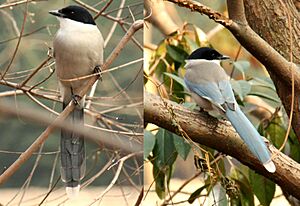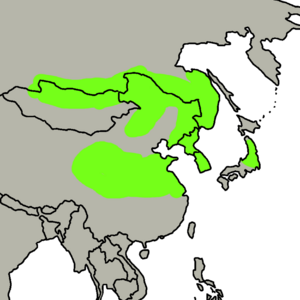Azure-winged magpie facts for kids
Quick facts for kids Azure-winged magpie |
|
|---|---|
 |
|
| Conservation status | |
| Scientific classification | |
| Genus: |
Cyanopica
|
| Species: |
cyanus
|
 |
|
| Synonyms | |
|
Cyanopica cyana |
|
The azure-winged magpie (scientific name: Cyanopica cyanus) is a beautiful bird that belongs to the crow family. These birds are about 31–35 cm long, which is roughly the length of a school ruler. They look a bit like the common Eurasian magpie, but they are slimmer with smaller legs and a daintier beak.
This magpie has a shiny black cap on its head and a bright white throat. Its back and belly are a soft light grey. The most striking parts are its wings and long tail, which are a lovely azure blue color. Their tail feathers can be quite long, reaching 16–20 cm! You can find them living in different kinds of coniferous (like pine forests) and broadleaf forests. In some places, especially in eastern areas, they even live in parks and gardens.
Contents
Where Do Azure-Winged Magpies Live?
These amazing birds live across a huge area in eastern Asia. You can find them in countries like China, Korea, and Japan. They also live further north in Mongolia and southern Siberia.
For a long time, people thought the Iberian magpie, which lives in Spain and Portugal, was the same species. But new scientific tests on their genes have shown that they are actually different species! This means the azure-winged magpie is unique to Asia.
How Do Azure-Winged Magpies Behave?
Azure-winged magpies often search for food together. They might forage as a family group or even join up with several other groups. Sometimes, these groups can become very large, forming flocks of up to 70 birds! The biggest groups usually gather after the breeding season and stay together throughout the winter.
What Do Azure-Winged Magpies Eat?
Their main diet includes acorns (which are oak seeds) and pine nuts. But they also love to eat invertebrates like insects and their larvae. They enjoy soft fruits and berries too. If they live near people, you might even see them eating scraps of food in parks and towns.
Nesting and Raising Young
These magpies usually build their nests in loose, open groups. They typically have just one nest in each tree. A female magpie usually lays 6 to 8 eggs. She then sits on them to keep them warm for about 15 days until they hatch.
Interestingly, some azure-winged magpies have "asynchronous broods." This means their eggs hatch at different times, so the baby birds are different sizes. These magpies often lay more eggs and have more young birds successfully leave the nest compared to those whose eggs hatch all at once.
What Does an Azure-Winged Magpie Sound Like?
The voice of the azure-winged magpie is quite distinct. It's a quick, metallic sound that goes kwink-kwink-kwink. This call is usually started with a single krarrah sound.
Images for kids



